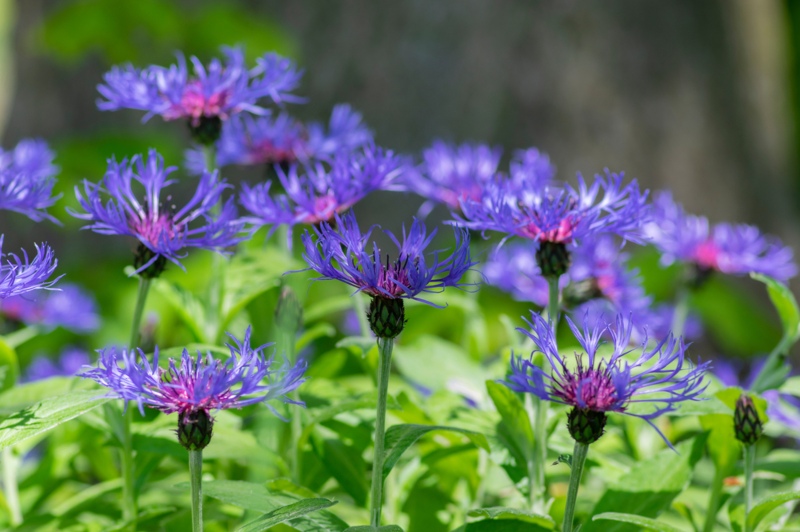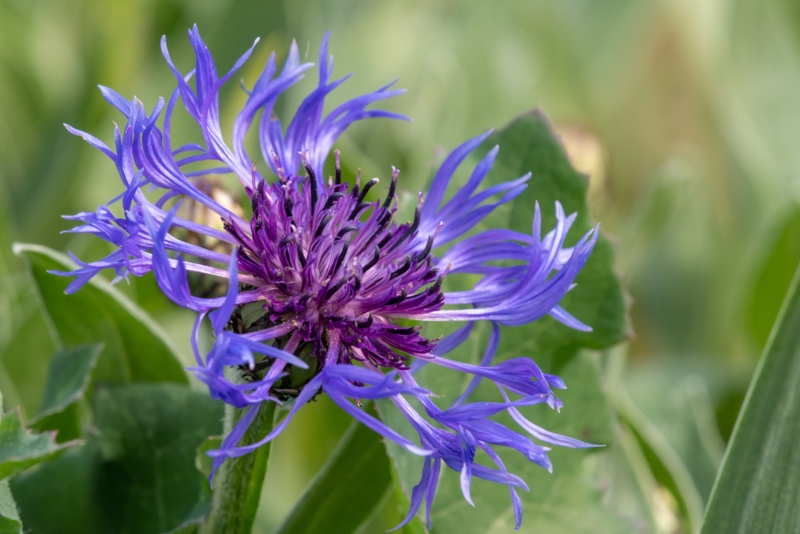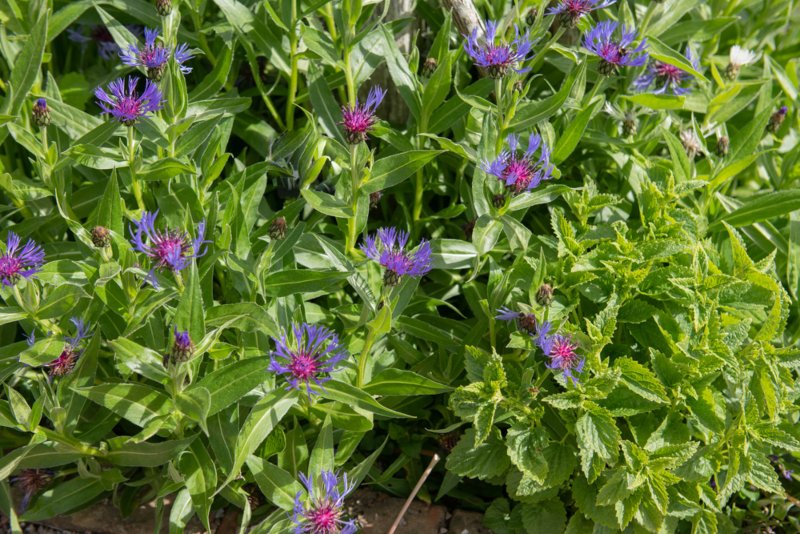The mountain bluet, Centaurea montana, also called the mountain cornflower or bachelor’s button, originated in the mountains of Europe. It’s readily identifiable by the shape of its burgundy flower heads, out of which grow multiple tubular blue-purple flowers.
Mountain bluets are similar in appearance to their annual cousins, the cornflower. However, its perennial nature and ease of care have spread across the British Isles, Scandinavia, and North America. In fact, in British Columbia, it has spread so aggressively that it’s now considered an invasive weed.

But, one person’s weed is another person’s ornamental treasure. The same features that make them a nuisance elsewhere make them perfect for novice gardeners who want an easy-to-care-for plant. Established plants practically care for themselves in a suitable climate. The biggest chore is keeping them from spreading out of control.
| Botanical Name: | Centaurea montana |
| Common Name(s): | Mountain bluet, perennial bachelor’s button, perennial cornflower |
| Plant Type: | Clumping herbaceous perennial |
| Mature Size: | 1-2 ft. tall; 1-1.5 ft. wide |
| Sun Exposure: | Full sun |
| Water Needs: | Dry to medium |
| Soil Type: | Clay, loam, sand |
| Soil pH: | Acid, neutral, alkaline |
| Bloom Time: | May – June |
| Maintenance: | Low |
| Flower Color: | Blue, red |
| Hardiness Zones: | 3-8 |
| Toxicity: | Not toxic |
Mountain Bluet Care
Mountain bluets are insanely easy to care for – so much that they are considered an invasive weed, such as in British Columbia. They thrive anywhere in hardiness zones three to eight and can even do well as far south as zone nine.
Their alpine origins in the southern mountain ranges of Europe give them a unique drought tolerance and hunger for sun and loose, nutrient-deficient soils. Once established, mountain bluets thrive on a bit of neglect. The only thing they won’t tolerate is over-watering.

Light
Mountain bluets grow best with lots of full, direct sunlight, at least six hours per day. However, they tolerate some shade. Less than ideal conditions may reduce the need for pruning to avoid invasive spreading.
Water
Juvenile plants need frequent watering, but once established, mountain bluets are impressively drought-tolerant. This is one plant that’s better to water too little as opposed to too much. Mountain bluets won’t stand for being waterlogged, so let mature plants dry out often.
Temperature and Humidity
Mountain bluets are endemic to the southern European mountain ranges, and so they prefer similar environmental conditions when grown elsewhere. They do best in the more northern, sub-alpine areas of their hardiness zone, where temperatures are cooler.
However, as anyone who’s ever spent time in the mountains can tell you, the weather is unpredictable, and the climate can vary widely. This means mountain bluets will grow adequately at just about any temperature and only slightly less vigorously in hotter climates.
Soil
Sub-alpine mountain ranges, like the ones where mountain bluets originate, tend to have inferior soils with limited nutrient content. Plants like the mountain bluet that flourish in such climates have adapted to those soils.
The mountain bluet can tolerate soils of nearly any acidity and prefer poorer soils over richer ones. Just make sure to choose a medium that’s well-draining to avoid waterlogging the roots, which mountain bluets won’t tolerate.
Fertilizer
Fertilizing mountain bluets is unnecessary and often counterproductive. Having adapted to the sparse nutrients of sub-alpine mountain soil, these plants rarely need extra supplementation. They often prefer poorer soils, and fertilizing may be counterproductive.
Are Mountain Bluets Toxic?
Mountain bluets are not known to be toxic.

Propagation
Mountain bluets readily self-propagate by spreading at the root level and self-seeding. You can propagate them yourself by digging up established clumps, dividing them, or collecting seeds and planting them yourself.
Growing From Seed
To grow mountain bluets from seed, you’ll want to start them indoors about a month before you intend to plant them outdoors. You can also sow them in rows directly outdoors if you prefer not to start them indoors first.
Whether indoors or out, make sure to cover them in about a half-inch of medium to give them plenty of darkness to germinate. Mountain bluets will take anywhere from two to four weeks to germinate, and you can move indoor seedlings outdoors once they reach two inches.
Deadheading and Pruning
Deadhead mature plants by removing the spent flower stalks after blooming. Deadheading may encourage a second, less abundant flowering later in the summer. If you want larger blooms, you can pinch off up to a third of the tiny flower buds as they develop.
You can enhance the shape and vigor of your mountain bluets by pruning them back to a node once a year using a fingernail or pruners. Divide established plants every few seasons to avoid aggressive spreading. Unchecked colonies can escape and have become invasive in British Columbia.




